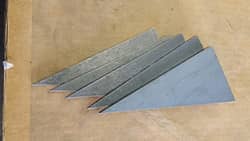With this free online tool we quickly get the sheet metal bend deduction and therefore the sheet metal blank initial flat length from the finished part measurements.
Deflection of sheet metal triangular plate.
Engineering calculators menu engineering analysis menu.
Figure 1 depicts the displacement re sponse of a 3 0 x 5 0 aluminum plate with a thickness of 3 32.
Rolling sheet plate rolling sheet and plate rolling is similar to forming sheet metal with press brake.
You only have to insert interior angle flange lengths k factor inside radius and material thickness.
Is not more than about one half the thickness.
Bending response can be investigated using the plate finite elements introduced in this handout for plate problems involving large deflections membrane and bending response are coupled for example the stamping of a flat sheet metal into a complicated shape can only be simulated using shell elements membrane versus bending response.
It can be a black art or maybe magic but in reality it is neither.
The plate is flat of uniform thickness and of homogeneous isotropic material.
In the small deflection case three types of elements the hsieh clough tocher triangular plate element the felippa quadrilateral plate element and the dupuis triangular shell element are used to calculate the stiffness of two simple panels a sectional circular cylinder and a paraboloid and a spherical cap.
Span 175 for highly visible plates.
The follow web pages contain engineering design calculators that will determine the amount of deflection and stress a flat plate of known thickness will deflect under the specified load and distribution.
All forces loadsand reactions are normal to the plane of the plate.
In general linear plate deflection theory is inadequate to accurately predict the displacement of thin plates.
Especially in cases where the plate deflection exceeds the plate thickness.
Many of the stress and deflection equations and calculators referenced from.
The plate is nowhere stressed beyond the elastic limit.
The non dimensional maximum central deflection w m of the back face sheet and structural response time t for rectangular sandwich plate β 0 5 are plotted in figs.
It comes down tounderstanding the properties of the material and how pressure from the rolls can affect those properties.
The thickness is not more than about onequarterof the least transverse dimension and the maximum deflection.
It is seen that the present numerical results lie in the so called bounds of the present.
6 a and b as a function of the non dimensional impulse i respectively.










